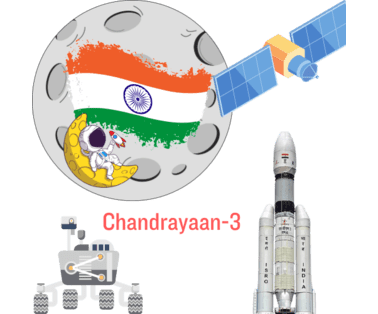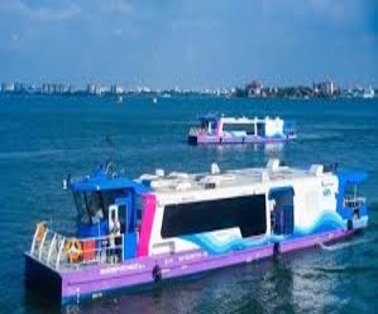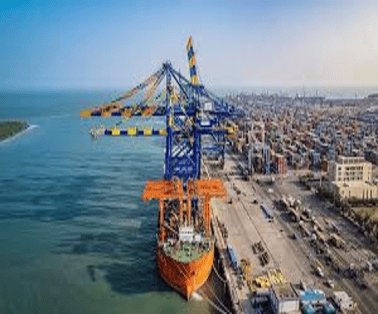India’s Moon mission Chandrayaan 3 scripted history by successfully landing on the lunar surface.
Key Points on Chandrayaan 3
- With the Lander accomplishing a ‘soft landing’ on the Moon’s south pole, India becomes the only country to have ever done so.
- The successful moon mission has made India the fourth country to achieve a soft landing on the lunar surface after the US, China, and the erstwhile Soviet Union.
- The Vikram lander began its descent toward the moon surface at a velocity of 1.68 km per second.
- It then slowed down before beginning a powered vertical descent to the surface of the moon.
Chandrayaan 3
- Chandrayaan 3 is a follow-on mission to Chandrayaan-2 to demonstrate end-to-end capability in safe landing and roving on the lunar surface.
- It consists of Lander and Rover configuration.
- ISRO launched the Mission by using an LVM3 vehicle on 14th July 2023 from Sriharikota
- Chandrayaan-3 consists of an indigenous Lander module (LM), Propulsion module (PM) and a Rover with an objective of developing and demonstrating new technologies required for Inter planetary missions.
- The Lander will have the capability to soft land at a specified lunar site and deploy the Rover which will carry out in-situ chemical analysis of the lunar surface during the course of its mobility.
- The main function of PM is to carry the LM from launch vehicle injection till final lunar 100 km circular polar orbit and separate the LM from PM.
- Apart from this, the Propulsion Module also has one scientific payload as a value addition which will be operated post separation of Lander Module.
Objectives Of Chandrayaan 3
The objectives of the Chandrayaan 3 mission are:

Technologies
Advanced technologies are present in Lander such as:

Soft Landing and South Pole
- Soft landing simply means landing at a gentle, controlled speed to not sustain damage to a spacecraft.
- Doing so showcases a spacecraft’s technical capabilities. The landing site is near the south pole of the moon at 70 degrees latitude.
- All of the previous spacecraft to have landed on the Moon have landed in the region near the Moon’s equator, firstly because it is easier and safer here.
- The terrain and temperature are more conducive for a long and sustained operation of instruments. Sunlight is also present, offering a regular supply of energy to solar-powered instruments.
- The polar regions of the Moon, however, are different. Many parts lie in a completely dark region without sunlight, and temperatures can go below 230 degrees Celsius.
- This creates difficulty in the operation of instruments. In addition, there are large craters all over the place.
- As a result, the polar regions of the Moon have remained unexplored. The extremely cold temperatures could mean that anything trapped in the region would remain frozen in time, without undergoing much change.
- The rocks and soil in Moon’s north and south poles could therefore provide clues to the early Solar System.
- Notably, Chandrayaan-2 also planned to land in this region in 2019, but it was not able to accomplish a soft landing and lost contact after it hit the surface.
What Will Happen After Chandrayaan 3’s Successful Landing On The Moon?
- Spacecraft are often carrying certain instruments and experiments with them (called payloads) that observe and record what is happening in Space.
- This information is then relayed to Earth for scientists to analyse and study.
- The six payloads on the Vikram lander and rover Pragyan remain the same as the previous mission.
- There will be four scientific payloads on the lander and there are two payloads on the Rover
Payloads
The objectives of scientific payloads planned on Chandrayaan 3 Lander Module and Rover are provided below:
|
Sl. No |
Lander Payloads |
Objectives |
|
|
1. |
Radio Anatomy of Moon Bound Hypersensitive ionosphere and Atmosphere (RAMBHA) |
Langmuir probe (LP) |
To measure the near surface plasma (ions and electrons) density and its changes with time |
|
2. |
Chandra’s Surface Thermo physical Experiment (ChaSTE) |
To carry out the measurements of thermal properties of lunar surface near polar region. |
|
|
3. |
Instrument for Lunar Seismic Activity (ILSA) |
To measure seismicity around the landing site and delineating the structure of the lunar crust and mantle. |
|
|
4. |
LASER Retroreflector Array (LRA) |
It is a passive experiment to understand the dynamics of Moon system. |
|
|
Sl. No |
Rover Payloads |
Objectives |
|
1. |
LASER Induced Breakdown Spectroscope (LIBS) |
Qualitative and quantitative elemental analysis & To derive the chemical Composition and infer mineralogical composition to further our understanding of Lunar-surface. |
|
2. |
Alpha Particle X-ray Spectrometer (APXS) |
To determine the elemental composition (Mg, Al, Si, K, Ca,Ti, Fe) of Lunar soil and rocks around the lunar landing site. |
|
Sl. No |
Propulsion Module Payload |
Objectives |
|
1. |
Spectro-polarimetry of HAbitable Planet Earth (SHAPE) |
Future discoveries of smaller planets in reflected light would allow us to probe into variety of Exo-planets which would qualify for habitability (or for presence of life). |
Chandrayaan 2 Failure
Changes in Chandrayaan 3
“Failure-based design” instead of the “Success-based design”:
- The failure-based design means the calculation and programming of all the probable scenarios that can go wrong.
- These include failure of electronics, engine failure, unable to reach the landing spot, sensor failure, algorithm failure, velocity higher than required, etc.
- Thus, if everything, including sensors, fails, the Vikram will still make the landing.
Increase in the landing area:
- The target area of Chandrayaan-3 is 4km x 2.4km area instead of 500m x 500m targeted by Chandrayaan-2.
More fuel to Lander:
- It will facilitate the Lander to travel longer distances to the landing site and, if needed, to the alternate landing site.
Help from Chandrayaan-2 orbiter:
- The Chandrayaan-3 mission does not carry an orbiter; it will use high-resolution images from the Chandrayaan-2 orbiter.
More robust integrated craft:
- The weight of the payload of Chandrayaan-3 has been kept more than the Chandrayaan-2, with the Lander having most of the extra weight.
- The number of thrusters has decreased from five to four without the central thruster.
- The legs are now sturdier to ensure that they can land even at a higher velocity.
- Use of additional solar panels to ensure power generation after a soft landing regardless of the weather on the Moon.
To Download Monthly Current Affairs PDF Click here
Click here to get a free demo
Everything About CLAT 2025
Frequently Asked Questions
Japan has not achieved a soft landing on lunar surface.
The Chandrayaan-3 mission’s Lander is known as:
The Chandrayaan-3 mission’s Lander is known as: Vikram
Chandrayaan-3 has been launched from which centre?
Chandrayaan-3 has been launched from Satish Dhawan Space Centre
Why landing in the south pole is difficult?
landing in the south pole is difficult because
- Extreme temperature
- There are large craters all over the place.
Chandrayaan-2 failed in the final phase of its mission in the year??
Chandrayaan-2 failed in the final phase of its mission in the year 2019




